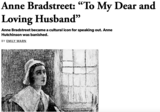
Anne Bradstreet became a cultural icon for speaking out. Anne Hutchinson was banished.
- Subject:
- English Language Arts
- Material Type:
- Reading
- Provider:
- Poetry Foundation: Resources for Educators
- Date Added:
- 02/01/2024

Anne Bradstreet became a cultural icon for speaking out. Anne Hutchinson was banished.
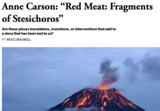
Are these pieces translations, inventions, or interventions that add to a story that has been lost to us?
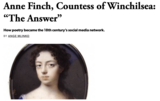
How poetry became the 18th century’s social media network.

Drawing upon the online archives of the U.S. Holocaust Museum, this lesson helps students to put the events described by Anne Frank into historical perspective, and also serves as a broad overview of the Nazi conquest of Europe during World War II. After surveying the experiences of various countries under Nazi occupation, the lesson ends with activities related specifically to the Netherlands and Anne Frank.

This lesson concentrates on Anne Frank as a writer. After a look at Anne Frank the adolescent, and a consideration of how the experiences of growing up shaped her composition of the Diary, students explore some of the writing techniques Anne invented for herself and practice those techniques with material drawn from their own lives.
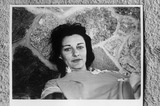
The impersonal power of a confessional classic.

A challenging, fun card game that helps students learn about their rights under the Bill of Rights, the first 10 amendments to the Constitution. The game offers three levels of play: Easy, Normal, Difficult.

Students learn how to annoate text in Google Docs.

This informational text explains that while both the Arctic and Antarctica are cold, Antarctica is much colder and drier - a polar desert. The text is written at a grade four through grade five reading level. This is a PDF containing the informational text and a glossary.

This is a phenomenon video for 3.2.4. Science Phenomena: 3rd grade - Ecosystem Change
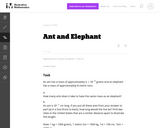
In this problem students are comparing a very small quantity with a very large quantity using the metric system. The metric system is especially convenient when comparing measurements using scientific notations since different units within the system are related by powers of ten.
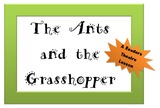
This Lesson Plan uses a Readers Theatre "The Ant and the Grasshopper" by Lois Walker to learn about protagonists and antagonists. Students compare similarities and differences between the two using a Venn diagram and describe the similarities and differences.

This video segment adapted from NOVA explains why ice sheets move. To find out how fast they move, scientists carve a tunnel through a glacier.

What would happen if a portion of the Antarctic Ice Sheet were to melt? This video segment adapted from NOVA uses animations to show the effect of a 6-meter sea-level rise on coastal cities across the world.
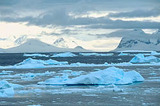
This resource is a Social Studies student activity that utilizes Utah's Online Library resources - specifically, Gale's Reference Collection, Gale's Global Issues in Context, and Gale's Biography in Context to help students learn about Antarctica.

What happens when the ground under your feet is ice and it's moving? This video segment adapted from NOVA features some of the dangers faced by scientists conducting research in Antarctica.

This article describes a discovery of moss and ostracod fossils that led to a better understanding of Antarctica's climate history.

This article includes links to expository text for students in grades K-1, 2-3, and 4-5 about the climate differences between the Arctic and Antarctica.

This informational text explains that while both the Arctic and Antarctica are cold, Antarctica is much colder and drier - a polar desert. The text is written at a grade two through grade three reading level. This version is a full-color PDF that can be printed, cut and folded to form a book. Each book contains color photographs and illustrations.

This video segment adapted from NOVA uses microwave images to reveal how sea ice doubles the size of Antarctica each winter. Rare footage shows how sea ice crushed the famous ship Endurance in 1914.